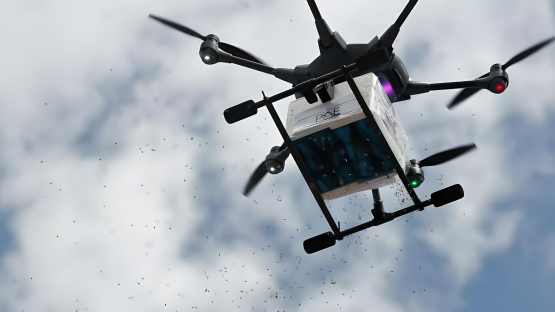A five-year long IAEA research project yielded new knowledge, tools and novel protocols for monitoring, marking, handling, transporting and releasing of sterile males of the world’s deadliest animal: the mosquito.
In recent years, mosquito-transmitted dengue has become a major international public health burden due to the increasing spread of invasive mosquito species of the genus Aedes, which also transmit chikungunya, Zika, and yellow fever. Recent increase of dengue cases, Zika outbreaks in the Americas in 2015 and 2016, the low effectiveness of insecticides and the environmental issues associated with classical insecticide use for mosquito control have increased the demand to develop new environment-friendly and sustainable approaches. The sterile insect technique (SIT) is one such method to control major disease-transmitting mosquito species and thus to improve human health.
The SIT is a component of area-wide integrated pest management (AW-IPM) programmes with the potential application for use against mosquitoes. The Joint FAO/IAEA Centre of Nuclear Techniques in Food and Agriculture has initiated the development of the SIT package as a tool for controlling mosquito vector populations. The SIT requires producing several millions of male mosquitoes, sterilizing and transporting them to the release sites after first being chilled for easy handling during the process flow, with minimal detrimental impact on their quality and sexual competitiveness. Methods for population monitoring are also essential, so that the releases can target the wild population, measure the male quality, and evaluate the effectiveness of the SIT application on the suppression of wild populations.
Some of the critical issues for improving the SIT package for mosquitoes include the development and optimization of handling, transporting, and releasing procedures with no significant impact on sterile male survival, dispersion, and sexual performance. Furthermore, affordable and efficient tools to monitor the mosquito population before and during the releases of sterile males are needed.
The main objective of the 5-year IAEA coordinated research project (CRP) on Mosquito Handling, Transport, Release and Male Trapping Methods was to provide the necessary advances in these techniques to enable the SIT application against mosquitoes and help reduce vector populations in affected countries. The CRP that involved 22 scientists from 19 countries resulted in the following key achievements:
- Novel and efficient trapping methods were developed and assessed for mosquito surveillance of an AW-IPM programme with an SIT component. An important next step will be to upscale these methods to mosquito SIT pilot projects.
- A novel large scale insect marking technique using Rhodamine-B was also developed and evaluated. This technique has the advantage of marking all the tissues of the mosquitoes, including sperm that can be retrieved and identified in mated females, and thus with great potential to estimate the sexual competitiveness of sterile male mosquitoes under field conditions.
- The impact of the temperatures, time, and compaction levels, and their interactions were explored for the handling, shipment, and transportation of chilled males. The effect of these conditions on male quality was also assessed. Based on these results, suitable environmental conditions for short and long-distance shipment were achieved for Aedes aegypti, Aedes albopictus and Aedes polynesiensis.
- Concerning the release of mosquitoes, methods for ground and aerial releases (using drones) were developed. A Remotely Piloted Aircraft System with an embedded mosquito release device developed and evaluated under laboratory and field conditions for Ae. aegypti with negligible impact on male quality. While drone aerial release is a powerful and cost effective tool for mosquito releases, there are still several challenges to implement this approach in SIT pilot projects against mosquitoes.
The research carried out in the framework of this CRP generated 22 scientific publications in peer-reviewed journals and several presentations in international and national scientific meetings. The final CRP results will be published in a special issue of a peer-reviewed scientific journal. The next step is to transfer these new tools to the Member States to benefit their mosquito SIT pilot and operational projects worldwide.






